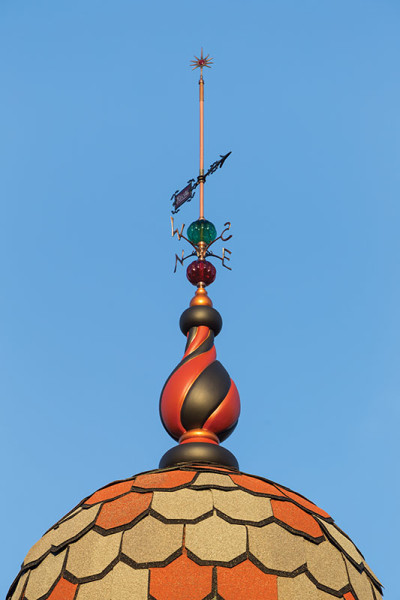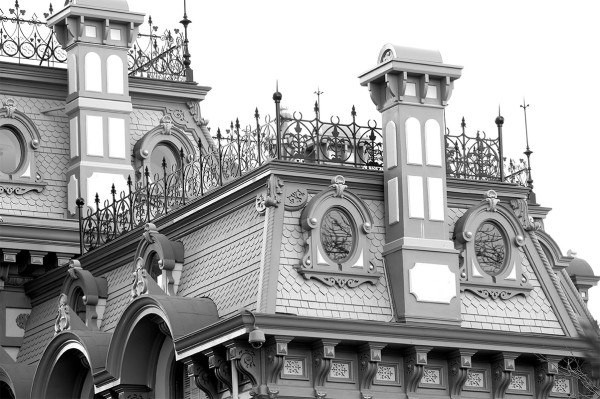
A lightning rod on the tower of the author’s house. (Photo credit: William Wright)
Lightning rods are an American invention, thanks to Benjamin Franklin’s 1740s experiments with electricity. Patriotically, he refused to patent his invention, and by the 1760s lightning rods were marketed throughout the Colonies.
A lightning strike can not only start a fire but also blow apart even masonry, and may injure or electrocute indoor occupants. The high heat of the strike can flash-steam water, causing an explosion (it’s why trees shatter when hit). During a storm, it’s dangerous to be near a filled sink or bathtub, and to stand too close to conductive metal, like a stove.
The height of the building is an important consideration. Church spires used to be the highest point in a town, so pragmatic pastors told congregants to stay away, not come to pray, during thunderstorms.
The Franklin Rods were simple: a pointed iron spike 8′ to 10′ tall with a gilded tip (to prevent rust), fastened to the highest point of a building. The lightning’s path from storm clouds was thus facilitated (though neither directly attracted nor repelled), deflecting it away from the structure, into the rod, and then down a low-resistance brass wire to the earth. (Turned out that Franklin’s pointy design had problems, as it tended to ionize the air, making it conductive and thus a strike more likely. British scientists maintained that a rod topped with a ball was better. King George III had his palace equipped with blunted rods, but Americans stuck with the pointy ones, which was taken as a sign of their bad attitude.)
Today’s rods are called “air terminals,” and they’re accompanied by bonding conductors and cables connecting them and running to the ground, along with two or more grounding rods or plates in the earth. Today’s rods are usually made of aluminum or copper; a pointed Franklin rod looks historically correct. Rods at least 1o” higher than the structure are placed at intervals along high points such as the roof crest, ridge, chimney, or along the perimeter of a flat roof. A braided copper or aluminum cable made for lightning systems connects the rods and runs into the ground to dissipate a charge. To avoid oxidation and even fire, don’t mix copper and aluminum components; thus, don’t use a copper rod with aluminum roofing or siding. Keep aluminum components away from copper roofing or gutters.
Installation is straightforward, though the path to the ground should be as short and straight as possible. Bends in the wire cause magnetic field crowding, and may eject or arc the current to a conductive element such as wiring or plumbing. Wires should not be run across roof flashing. It’s safer to run wires outside the house to keep side flashes away from the interior. The number of rods needed is calculated by each “protection cone,” which radiates conically from the tip 45° from perpendicular; a rule of thumb is that a 12″ rod will protect about 20′ of roof. See diagrams at lightningrodsupply.com. To protect electronics, surge arrestors or protectors should be installed on incoming power sources: telephone lines, electrical service panels. In-ground gas lines, water lines, and well casings might attract a current and should be protected.

(Photo courtesy: Allen Architectural Metals)
Keep It Inspected
Regular inspection is the key to safe functioning. Roofers, chimney masons, and house painters may disconnect cables and connectors and forget to reattach them; in your contracts, specify a mandatory inspection by a UL-certified inspector. Wires and cables may have outdated or inadequate surge protectors, grounding systems may need updating…but general electricians may not be experienced in lightning protection requirements. Have a system installed by a UL-certified installer, whose work must pass third-party inspection. Cost is usually between $2,500 and $4,500. Your insurance company will approve.
Ornaments for the Roof
“More is better” might have been the late 19th century’s motto, when fanciful iron cresting and more were added to rooflines. Lightning rods were often fancy, embellished with directional wind arrows, figural weathervanes, and ornamental glass balls—red, blue, green, and also white milk glass. Balls found broken on the ground were evidence of a strike. Here are a couple of my favorite sources, who sell everything from glass balls to time capsules for your roof system: lightningrodparts.com; ferroweathervanes.com







